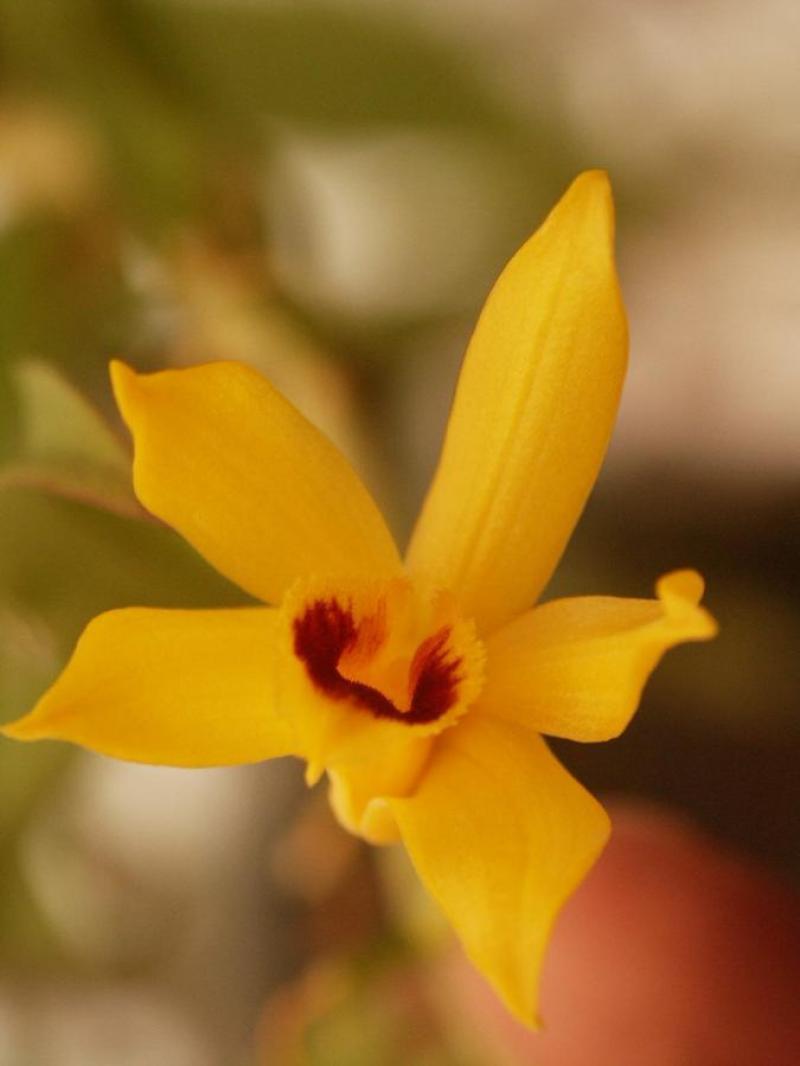Dendrobium ochreatum
Also known as: The Stem Clasping Tube Dendrobium or Dendrobium cambridgeanum Callista ochreata Ueang ta Khap - Ueang mieng - Ueang kham khaw - Ueang kham phak prap in the subfamily: Epidendroideae
Native to: India Thailand
General Information
The Stem Clasping Tube Dendrobium is a small to medium sized sympodial cool to warm growing epiphytic, lithophytic or terrestrial orchid belonging to the sub family Epidendroideae native to India and Thailand.
Plant Description
Sympodial. Grows to 15-76cm. Each new growth has numerous lance shaped leaves that grow to 5-13cm long. Pseudobulbs grow to 15-76cm
Flowers
Numerous fragrant blossoms appear
Fragrance
The orchid is fragrant.
Care Notes
These orchids live in environments that receive constant moisture, high humidity, and are surrounded by other plants such as ferns and mosses which not only attract moisture but compete for it as well.
As a consequence they can be difficult to keep healthy in an artificial environment where a constant balance has to be maintained between providing constant moisture to the roots, but also allowing them to not become soggy and dry quickly as they would in the wild. For this reason it's important to take into account the size of the plant, the health and fragility of the root system, and also think about your watering habits. If you water frequently you can use a media that drains more freely, if you water less reliably you will need to find a media that offers retention and keeps humidity around the roots without being soggy.
Because these orchids like high amounts of water, other plants such as ferns and weeds may start to grow alongside the orchid, whose roots can make the media quite dense, effectively strangling the orchid's roots, it's best to pluck them out before they become a problem. Fungus and bacteria can be an issue as well, but usually are a sign of overwatering, smell the media occasionally to check, and increase airflow, reduce watering, and adjust temperatures accordingly (often bacteria only flourish in warmer temperatures, fungus less so).
Fragrant:
- IsFragrant
Climate
The orchids are well adapted for hot weather, accompanied by sporadic, unpredictable rainfall and a generally dry climate. They can tolerate a lot of neglect as they are quite used to it, however they can be prone to underwatering and may collapse in cold, wet weather.
For this reason it's best to dedicate a sheltered, protected area for them where the watering can be controlled, such as a corner of a greenhouse or in a sheltered balcony. They can also do well hung near the roof of a shadehouse or sheltered greenhouse where they receive the extra heat but not as much water as other plants.
Grows at low to high elevations. Rainfall ranges from 8mm to 292mm per day, heaviest in September and lightest in January. Humidity ranges from 58% to 83%, highest in August and lowest in March. Temperature ranges from 6C to 28C, highest in April (17C to 28C) and lowest in January (6C to 22C).Watering
These orchids prefer a constant supply of moisture, with a slight drying out between waterings. Saucers can be placed under pots to retain moisture during hot weather, however the saucers should be removed or let to dry every 1-2 weeks to prevent rot. Keep an eye on the plant especially in hot weather and look for cues of under/overwatering and adjust accordingly.
During Summer and Winter, be sure to keep media moist.Fertiliser
These orchids do not need to be regularly fertilised and roots may be sensitive to salt build-up, dying back and therefore impairing the plants growth or even killing it.
If fertilising, use half to quarter of the recommended amount of fertiliser. If they receive fertiliser as part of a collection, be sure to flush out the pots regularly with fresh water and monitor the roots by checking how much resistance is given by the plant when nudged in its pot or mount. If the plant becomes wobbly or loose, repot in fresh mix or rinse the media/mount thoroughly and do not fertilise for at least 3 months.
Apply fertiliser regularly at half strength year round. This plant is sensitive so apply fertiliser sparingly at one quarter recommended strength or less. Use a high Nitrogen fertiliser during Spring and Summer. Use a high Phosphorous fertiliser during Summer.Potting
These plants can be sensitive to repotting though should not require repotting regularly. Repotting should be done when the mix has broken down to the point that it doesn't absorb water or holds onto water for far too long, usually the plant shows a decline in growth as well. Repotting is best done after the growing season when the plant has died back.
The mix should be free draining, with a blend of 30% inorganic ingredients such as coarse sand, gravel or perlite, mixed in with about 70% organic ingredients such as peat, leaf litter or decomposed bark. Avoid commercial potting mixes as they can vary wildly and may contain "wetting agents" that can hold onto water for loo long, causing rotting and stunted growth.


